

12mm threaded rod
Dec . 06, 2024 03:31 Back to list
12mm threaded rod
Understanding 12mm Threaded Rods Uses, Benefits, and Considerations
Threaded rods, also known as all-thread rods or studs, are a vital component in various construction and engineering applications. Among the many sizes available, the 12mm threaded rod is particularly noteworthy. This article delves into the specifications, applications, benefits, and considerations surrounding 12mm threaded rods, providing a comprehensive understanding for those considering their use in projects.
Specifications of 12mm Threaded Rods
A 12mm threaded rod is a long, cylindrical piece of metal with continuous threads running along its length. The size denotes its nominal diameter—12mm, which is approximately 0.47 inches. Threaded rods typically come in various materials, including steel, stainless steel, and other alloys. The choice of material depends on the intended application and the environmental conditions to which the rod will be exposed.
The rods are produced in different thread pitch types, such as coarse and fine threads. The standard pitch for a 12mm threaded rod in the coarse version is generally around 1.75mm, while fine threads may have a pitch of 1.5mm or less. The choice between these will impact how the rod engages with the corresponding nuts and other hardware.
Applications of 12mm Threaded Rods
12mm threaded rods find extensive use across various industries due to their versatility. Here are some common applications
1. Construction In construction, threaded rods act as tensioning elements for structures such as bridges, buildings, and towers. They are often employed to support suspended ceilings, secure structural beams, or establish connections between components.
2. Machinery and Equipment Assembly These rods are also essential in machinery where certain elements need to be bolted securely together or where vibration resistance is required. They can be used together with nuts and various fittings to create robust assemblies.
4. Industrial Applications They are utilized in various manufacturing processes, including forming fixtures, machinery setups, and various types of manufacturing equipment. Their strength and adjustability make them ideal for dynamic industrial environments.
5. DIY Projects For hobbyists and DIY enthusiasts, 12mm threaded rods can be used in a range of projects, from furniture construction to home improvement tasks, where adjustable and sturdy connections are necessary.
12mm threaded rod

Benefits of Using 12mm Threaded Rods
One of the primary advantages of 12mm threaded rods is their strength-to-weight ratio. Being made from high-grade steel or stainless steel ensures they can bear substantial loads without compromising safety. Additionally, the use of nuts and washers with threaded rods allows for adjustments and ensures a secure fit.
Another benefit is their versatility. With the right fittings, 12mm threaded rods can be used in various applications, providing flexibility in design and construction methods. They are also readily available in most hardware stores and online, making them an accessible choice for many projects.
Considerations When Using 12mm Threaded Rods
While 12mm threaded rods offer many benefits, there are a few considerations to keep in mind
1. Corrosion Resistance If the application will expose the rods to moisture or chemicals, consider using stainless steel or applying a protective coating to prevent rust and degradation.
2. Length and Thread Count Ensure you select the appropriate length and thread count for your specific application. Over-tightening can lead to damage, while an insufficiently tightened rod can lead to structural failures.
3. Load Specifications Always check load specifications and ensure that the threaded rod is suitable for the weight and tension it will bear. Consulting with an engineer can be beneficial for critical applications.
4. Installation and Maintenance Proper installation techniques are crucial. In addition, periodic checks can ensure that connections remain tight and secure over time.
Conclusion
In summary, 12mm threaded rods are indispensable in a wide range of applications, offering strength, versatility, and ease of use. Whether in construction, machinery, or DIY projects, understanding their specifications, benefits, and proper usage can lead to more robust and reliable outcomes. As such, they should be considered an essential component in any toolkit, allowing users to achieve efficient and lasting results in their endeavors.
Latest news
-
Hot Dip Galvanized Bolts-Hebei Longze|Corrosion Resistance&High Strength
NewsJul.30,2025
-
High-Strength Hot-Dip Galvanized Bolts-Hebei Longze|Corrosion Resistance&High Strength
NewsJul.30,2025
-
Hot Dip Galvanized Bolts-Hebei Longze|Corrosion Resistance&High Strength
NewsJul.30,2025
-
Hot Dip Galvanized Bolts - Hebei Longze | Corrosion Resistance, High Strength
NewsJul.30,2025
-
High-Strength Hot Dip Galvanized Bolts-Hebei Longze|Corrosion Resistance, Grade 8.8
NewsJul.30,2025
-
Hot Dip Galvanized Bolts-Hebei Longze|Corrosion Resistance,High Strength
NewsJul.29,2025

